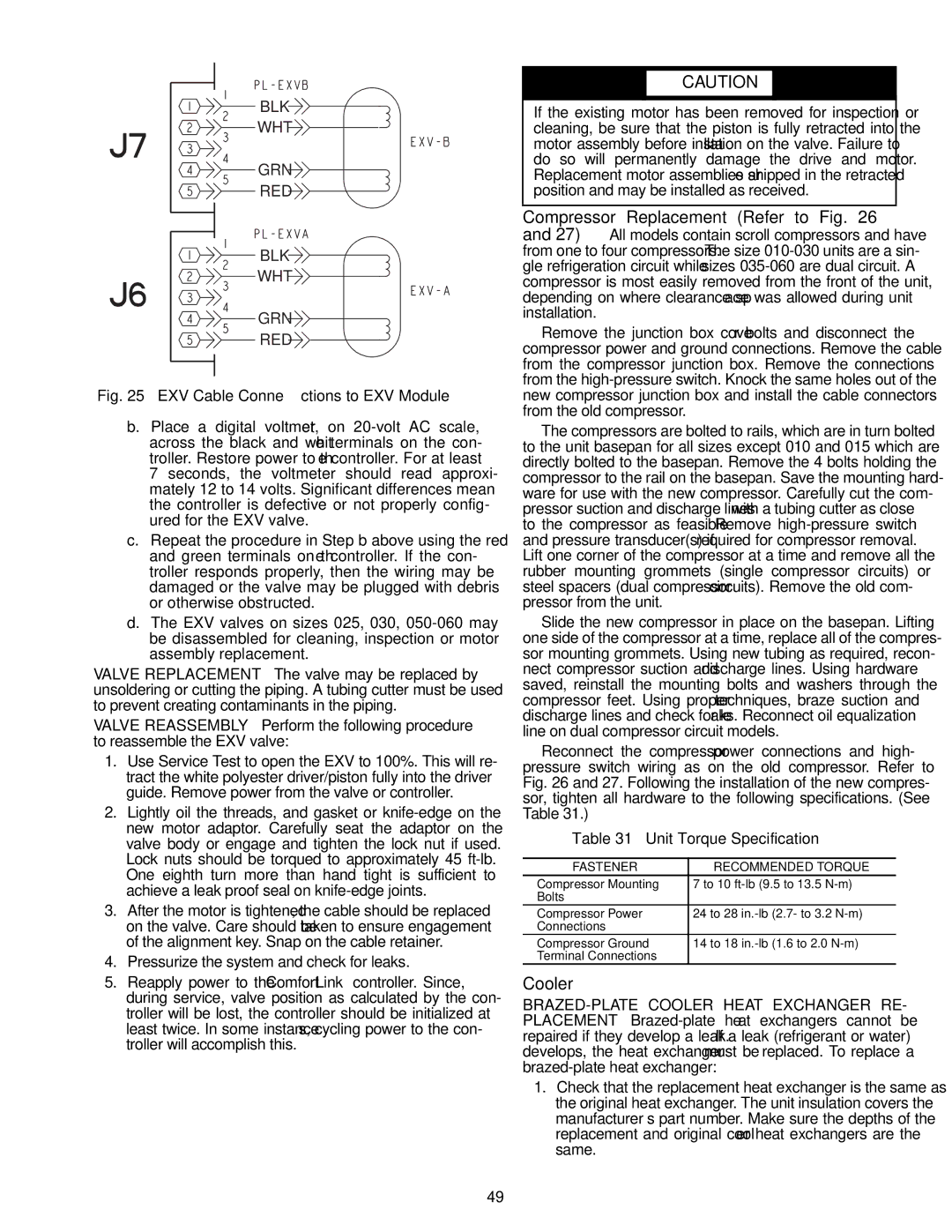Contents
Controls, Start-Up, Operation, Service, and Troubleshooting
Safety Considerations
Contents
Basic Controls Usage
General
Unit Sizes
Unit Nominal Capacity Tons
Accessory Navigator Display Module
SET Inputs Outputs Configuration Time Operating Alarms
Mode RUN Service Temperatures
Scrolling Marquee Display Menu Structure
Test
Strt
Run Status Mode and Sub-Mode Directory
Vers
SUB-MODE Keypad Display SUB-ITEM Comment Entry Expansion
SUB-MODE Keypad Display Comment Entry Expansion Test
Service Test Mode and Sub-Mode Directory
Outs
Cmpa
Pressure Mode and Sub-Mode Directory
Temperature Mode and Sub-Mode Directory
Set Points Mode and Sub-Mode Directory
Outputs Mode and Sub-Mode Directory
Inputs Mode and Sub-Mode Directory
SUB-MODE Keypad Display Comment Entry Expansion EXV
Configuration Mode and Sub-Mode Directory
SUB-MODE Keypad Display Comment Entry Expansion Unit
OPT1
OPT2
SUB-MODE Keypad Display Comment
XXX
XXX.X ΔF
Date
Time Clock Mode and Sub-Mode Directory
DST
Alarms Mode and Sub-Mode Directory
Operating Mode and Sub-Mode Directory
Operating Modes
Mode Item Expansion Description
Control Module Communication
Controls
Carrier Comfort Network CCN Interface
Thermistor Designations
CCN Communication Bus Wiring
Status Inputs
Output Relays
AUX
Almr
CCB
CHC
A30-4963
A30-4962
Typical Control Box for 30RAP035-060
A30-4964
Typical Wiring Schematic, 30RAP018-030 Units Power Wiring
A30-4966
Typical Wiring Schematic, 30RAP018-030 Units Control Wiring
5283
Typical Wiring Schematic, 30RAP035-060 Units Power Wiring
A30-5284
Typical Wiring Schematic, 30RAP035-060 Units Control Wiring
A30-4968
A30-4967
Page
CEPL130351
30RAP Unit Size Control Capacity Steps Capacity %
Deadband Multiplier
Operating Envelope for R-410A Compressor
A30-4969
A30-4970
Cooling Set Point Select
30RAP Unit Size FAN Stages
Control Methods and Cooling Set Points
Optional Factory-Installed Hydronic Pack
Control Occupancy Cooling SET Point Select Clsp Type State
CCN
→PM1E = YES
Configuring and Operating Dual Chiller Con
Rset
Dual Chiller Configuration Master Chiller Example
Number
Part
SUB-MODE Keypad Entry Display Item Expansion Comments
Rset Slave Complete
Dual Chiller Configuration Slave Chiller Example
Menu Configuration of 4 to 20 mA Cooling Set Point Control
To 20 mA Reset
Configuring Return Temperature Reset
Configuring Outdoor Air and Space Temperature Reset
Mode Keypad SUB Display
RED LED Entry Mode
Outdoor-Air Temperature Reset
To 20-mA Demand Limiting
Item Expansion Comment Entry Configuration
Configuring Demand Limit
PRE-START-UP
System Check
A30-4978
START-UP and Operation
30RAP Minimum Cooler Flow Maximum Cooler Flow Size
Operating Limitations
Temperature Limits for Standard 30RAP Units
Operation Sequence
Unit Size 30RA
Electronic Components
Service
EXV Steps
Unit Size 30RAP EXV Steps
Electronic Expansion Valve Details
A30-4971
Unit Torque Specification
Compressor Replacement Refer to Fig
Cooler
A30-4972
Check Refrigerant Feed Components
Oil Charge
A30-4974
A30-4973
LWT
Check Unit Safeties
Factory Settings, High-Pressure Switch Fixed
Unit Cutout CUT-IN
Thermistor Well
Temp Voltage Resistance Drop
100,260
143
Drop
86K Thermistor vs Resistance DTT
A30-499
A30-4975
A30-4976
Accsy
P50 Fault History Last 8 faults P51 Software version
A30-4977
Mode Nominal Voltage Control Input Start Jumper
TB1-TB2
TB13A-TB2
Fault Codes
Motormaster V Program Parameters for Operating Modes
Parameters Description Mode
PID
Replacement Modules
Maintenance
Replacement Replacement Part Module
Troubleshooting
30RAP Unit Cutout CUT-IN Size
Advanced Scroll Temperature Protection Label
Symptoms Cause Remedy
Troubleshooting
T051
Alarm and Alert Codes
T110
T153
T197
CCN
Alert GENERATED?
CSB
EMM
Compressor Stuck on Failure Alarms
Page
SUB-MODE Display Item Description Comment
Appendix a Display Tables
View
RUN
Strt
Appendix a Display Tables
Vers
Pressures Mode and Sub-Mode Directory
Cool
SUB-MODE Display Item Description Range Comment
Head
FRZ
GEN.O
SUB-MODE Display Item Description Comment
HP.B
HP.A
EXV.B
EXV.A
Rset
Bcst
Date
SUB-MODE Display Item Description Comment Time
DST
HOL.L
HD.19
HD.30
SCH.L
SUB-MODE Display Item Description Comment SCH.N
PER.1
PER.2
PER.7
PER.6
PER.8
Rcrn
Crnt
Hist
CCN Display Tables Aunit General Unit Parameters
Appendix B CCN Tables
CCN Display Tables Circaan Circuit a Analog Parameters
Description Value Units Point Name Forcible
CCN Display Tables Circban Circuit B Analog Parameters
Appendix B CCN Tables
CCN Configuration Tables OPTIONS1 Options 1 Configuration
CCN Configuration Tables Unit Unit Configuration
Description Value Default Units Point Name
CCN Display Tables Options Unit Parameters
CCN Configuration Tables Schedovr Timed Override Setup
CCN Configuration Tables OPTIONS2 Options 2 Configuration
CCN Configuration Tables Mmconf Motormaster Configuration
CCN Configuration Tables Display Marquee Display Setup
CCN Service Tables Service
Description Value Point Name
Description Value Units Point Name
Description Version Value
CCN Maintenance Tables Alarms
CCN Maintenance Tables PM-PUMP
CCN Maintenance Tables Runtest
CCN Maintenance Tables Dualchil
Setting
Appendix C Factory Settings for Pump and Manual Starters
Optional BACnet Communications Wiring
Appendix D Optional Bacnet Communications Wiring
Table a SW3 Protocol Switch Settings For MS/TP
Appendix D Optional Bacnet Communications Wiring
Table B Baud Selection Table
DS8 DS7 DS6 DS5 DS4 DS3
Specification Recommmendation
Table C MS/TP Wiring Recommendations
AWG
CL2P
Rmcorp
Wiring Specifications Recommended Vendors and Part Numbers
CMP
RUN LED Error LED Status
Table E LED Status Indicators
LED Status
Table G Network Points List
Control Mode
108
109
30RAP Maintenance Interval Requirements
Appendix E Maintenance Summary and LOG Sheets
Weekly
Quarterly
30RAP Weekly Maintenance Log
Appendix E Maintenance Summary and LOG Sheets
Unit Section Action Entry
30RAP Monthly Maintenance Log
PSI
113
30RAP Seasonal Shutdown Log
Copyright 2010 Carrier Corporation
Remove and use for Job File Project Information
START-UP Checklist for 30RAP Liquid Chiller
II. Preliminary Equipment Check
Design Information
Start and Operate Machine. Complete the Following
III. Unit Start-Up
Dual Chiller Control Only
Record Software Versions
Mode RUN Status
OPTIONS1 Options Configuration
Unit Configuration Settings
Submode Item Expansion Display Entry
OPT1
CCN CCN Network Configuration
OPTIONS2 Options Configuration
HP.A Head Pressure Cmp. Delta Configuration
HP.B Head Pressure Cmp. Delta Configuration
EXV.B Circuit B EXV Configuration
EXV.A Circuit a EXV Configuration
MM Motormaster Configuration Settings
EXV.B
Slct Setpoint and Ramp Load Configuration
Rset Reset Configuration Settings
Setpoint
Entry Expansion
SUB-MODE Keypad Display Comment

